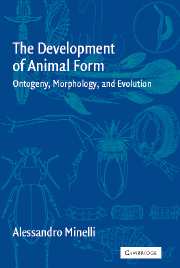Book contents
- Frontmatter
- Contents
- Preface
- Acknowledgements
- 1 The Nature of Development
- 2 Everything Begun to the Service of Development: Cellular Darwinism and the Origin of Animal Form
- 3 Development: Generic to Genetic
- 4 Periodisation
- 5 Body Regions: Their Boundaries and Complexity
- 6 Differentiation and Patterning
- 7 Size Factors
- 8 Axes and Symmetries
- 9 Segments
- 10 Evo-devo Perspectives on Homology
- Summary and Conclusions
- References
- Index
5 - Body Regions: Their Boundaries and Complexity
Published online by Cambridge University Press: 10 August 2009
- Frontmatter
- Contents
- Preface
- Acknowledgements
- 1 The Nature of Development
- 2 Everything Begun to the Service of Development: Cellular Darwinism and the Origin of Animal Form
- 3 Development: Generic to Genetic
- 4 Periodisation
- 5 Body Regions: Their Boundaries and Complexity
- 6 Differentiation and Patterning
- 7 Size Factors
- 8 Axes and Symmetries
- 9 Segments
- 10 Evo-devo Perspectives on Homology
- Summary and Conclusions
- References
- Index
Summary
Comparative molecular genetics is nothing but comparative anatomy by other means.
J. Deutsch 2001: 48Tagmosis
The bodies of many animals are obviously divided into regions: the head, thorax, and abdomen in insects; the prosoma and opisthosoma in spiders; and the head, trunk, and tail in vertebrates. Comparable distinctions apply to most other bilaterians, segmented and not segmented alike.
Is this distinction just a subjective description, or does it correspond to an intrinsic pattern? If the external regionalisation corresponds to a regionalised ‘internal description’, how far is this pattern comparable across lower and higher taxa? In other terms, is a head always a head? Is the trunk of a mollusc meaningfully comparable with that of a vertebrate?
An interesting feature of body regions, or tagmata, is their number. No zoology textbook assigns more than three to five regions to the animals with the most extensively patterned main body axis. Does this number correspond to some intrinsic constraint of body design?
When approaching the study of body tagmosis, we face the usual problems of definition. What is ‘really’ a tagma? How are its boundaries defined? Things are generally simple, but the more interesting questions are found in the exceptions.
Take, for example, the insect thorax. This is the second body region, between the head and abdomen. It comprises three segments, each of which bears a pair of legs. No ‘true’ leg is found on the head or abdomen segments.
- Type
- Chapter
- Information
- The Development of Animal FormOntogeny, Morphology, and Evolution, pp. 79 - 105Publisher: Cambridge University PressPrint publication year: 2003



